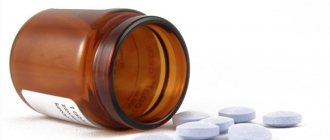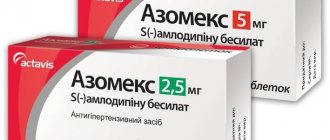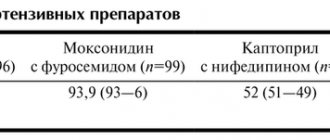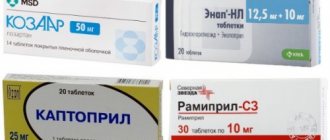Pharmacodynamics and pharmacokinetics
Pharmacodynamics
The drug belongs to dihydropyridine and is part of the group of “slow” calcium channel blockers. Affects the process of calcium entry into smooth muscle cells of peripheral and coronary arteries; suppresses the process of release of calcium ions from depots inside cells. The drug reduces the number of functioning channels, but does not affect the time and speed of their activation and restoration. It influences the processes of contraction and excitation of myocardial muscles and vascular smooth muscles.
In therapeutic doses, it normalizes the disturbed transmembrane current of calcium ions that forms during arterial hypertension . Increases blood flow in the heart muscle, does not affect venous tone, normalizes the functioning of collaterals, improves blood supply to ischemic heart muscle, reduces myocardial tone and peripheral vascular resistance, as well as the need for oxygen in the heart muscle, afterload. Causes moderate natriuresis , improves renal blood flow, has virtually no effect on heart rate, atrioventricular and sinoauricular nodes.
Pharmacokinetics
The drug is almost completely absorbed from the gastrointestinal tract . Bioavailability is 40 - 70%. High connection with blood proteins ( albumin ). Metabolized intensively in the liver (40-60%) to pharmacologically inactive metabolites. Cmax when taking 10 mg of the drug orally is achieved after one hour. The half-life is about four hours. Penetrates through the BBB . Excreted by the kidneys and through the intestines.
Cordafen 10 mg 50 pcs. Polpharma film-coated tablets
pharmachologic effect
Blocks calcium channels, inhibits the transmembrane flow of calcium ions into smooth muscle cells of arterial vessels and cardiomyocytes.
Composition and release form Cordafen 10 mg 50 pcs. Polpharma film-coated tablets
Film-coated tablets - 1 tablet. nifedipine - 10 mg excipients: potato starch; lactose; MCC; gelatin; talc; magnesium stearate shell: hydroxypropyl methylcellulose; polyethylene glycol 6000; quinoline yellow varnish E104; propylene glycol; titanium dioxide; talc in blister packs 25 pcs.; in a cardboard pack 2 packs.
Description of the dosage form
Yellow film-coated, biconvex tablets. At the fracture there is a porous yellow mass.
Directions for use and doses
For oral administration, the initial dose of the drug is 10 mg 3-4 times a day. If necessary, the dose is gradually increased to 20 mg 3-4 times a day. In special cases (severe arterial hypertension), for a short time the dose can be increased to 30 mg 3-4 times a day. The maximum daily dose is 120 mg. To treat a hypertensive crisis, as well as an attack of angina, the drug can be prescribed sublingually at a dose of 10-20 mg (rarely 30 mg), then the drug will take effect in 15-20 minutes. For long-term therapy, it is recommended to use retard tablets (long-acting) 20 mg (less often 40 mg) 2 times a day.
Pharmacodynamics
Relaxes the smooth muscles of peripheral arteries, incl. coronary, has a negative inotropic effect, reduces myocardial oxygen demand, reduces high blood pressure, peripheral vascular resistance and afterload on the heart. Improves coronary blood flow. Does not inhibit myocardial conductivity.
Pharmacokinetics
After oral administration, it is quickly and completely absorbed from the gastrointestinal tract. Cmax in plasma is reached after 0.5-2 hours. Food intake reduces the rate of absorption, but does not affect its magnitude. Protein binding - 92-98% (decreases with impaired renal or liver function). Subject to the "first pass" effect. Rapidly and completely metabolized in the liver by oxidation and hydrolysis with the formation of inactive metabolites. Excreted in urine and feces (70-80%). T1/2 is 2-5 hours. In patients with liver cirrhosis, the bioavailability of the drug increases.
Indications for use Cordafen 10 mg 50 pcs. Polpharma film-coated tablets
- prevention of angina attacks;
- arterial hypertension;
- hypertensive crises.
Contraindications
- decrease in blood pressure below 90 mmHg;
- severe heart failure;
- hypersensitivity to the drug.
Application Cordafen 10 mg 50 pcs. Polpharma film-coated tablets during pregnancy and breastfeeding
Contraindicated during pregnancy and breastfeeding.
special instructions
In case of acute myocardial infarction, severe cerebrovascular accidents, diabetes mellitus, impaired liver and/or kidney function (do not use the drug in high doses), in case of malignant hypertension and hypovolemia, as well as in patients on hemodialysis, Cordafen® should be used only in in a hospital setting under the strict supervision of a physician. If chest pain occurs during treatment, the drug should be discontinued. It is recommended to gradually discontinue the drug to avoid the development of withdrawal syndrome. During the course of treatment, it is necessary to avoid the use of alcohol (due to the risk of an excessive decrease in blood pressure), and smoking is not recommended. Should not be used during work by vehicle drivers and people whose profession involves increased concentration of attention.
Overdose
Symptoms: possible increased side effects.
Side effects Cordafen 10 mg 50 pcs. Polpharma film-coated tablets
- redness of the skin of the face and neck;
- headache, nausea, weakness;
- swelling, palpitations;
- constipation, abdominal pain;
- lowering blood pressure;
- increased attacks of angina, deterioration of liver function.
Drug interactions
Beta-blockers, diuretics, and other antihypertensive drugs enhance the hypotensive effect of Cordafen®, and nitrates enhance its antianginal effect. Calcium supplements reduce the effect of Cordafen®.
Contraindications
High sensitivity to the drug, aortic stenosis , unstable angina , collapse , age under 18 years, myocardial infarction , CHF , first trimester of pregnancy , cardiogenic shock , lactose intolerance, lactation, arterial hypotension .
Use with caution in patients with mitral valve stenosis , sinus node weakness, bradycardia , cerebrovascular accidents, liver/kidney diseases, hemodialysis , and over the age of 60 years.
Side effects
blood pressure , development of heart failure, arrhythmia , facial skin flushing, peripheral edema , feeling of heat, tachycardia , pain, palpitations dizziness , weakness, fatigue, headache , drowsiness , anxiety, increased appetite, gum hyperplasia , dyspepsia , dryness in the mouth, agranulocytosis , anemia , allergic reactions, arthritis , myalgia , arthralgia , increased daily diuresis , weight gain.
Cordafen 10mg n50 tab.
Dosage form:
dragees, oral drops, capsules, solution for infusion, tablets, film-coated tablets, extended-release tablets, extended-release film-coated tablets, rapid-retard tablets, controlled-release tablets
Pharmachologic effect:
Selective BMCC, a derivative of 1,4-dihydropyridine. It has a vasodilating, antianginal and hypotensive effect. Reduces Ca2+ current in cardiomyocytes and smooth muscle cells of coronary and peripheral arteries; in high doses suppresses the release of Ca2+ from intracellular stores. Reduces the number of functioning channels without affecting the time of their activation, inactivation and recovery. It uncouples the processes of excitation and contraction in the myocardium, mediated by tropomyosin and troponin, and in vascular smooth muscles, mediated by calmodulin. In therapeutic doses, it normalizes the transmembrane Ca2+ current, which is disturbed in a number of pathological conditions, primarily in arterial hypertension. Does not affect the tone of the veins. Strengthens coronary blood flow, improves blood supply to ischemic areas of the myocardium without developing the “steal” phenomenon, and activates the functioning of collaterals. By dilating peripheral arteries, it reduces peripheral vascular resistance, myocardial tone, afterload, myocardial oxygen demand and increases the duration of LV diastolic relaxation. It has virtually no effect on the SA and AV nodes and does not have antiarrhythmic activity. Increases renal blood flow, causes moderate natriuresis. The negative chrono-, dromo- and inotropic effects are overlapped by reflex activation of the sympathoadrenal system and an increase in heart rate in response to peripheral vasodilation. Time of onset of effect: 20 minutes for oral administration, 5 minutes for sublingual administration of capsule contents; duration of effect: 4-6 hours - for tablets and capsules, 12-24 hours - for prolonged forms.
Indications:
Angina pectoris (tension, stable without vasospasm, stable vasospastic, unstable vasospastic with ineffectiveness of beta-blockers and nitrates); arterial hypertension (including renovascular), relief of hypertensive crisis; Raynaud's disease and syndrome; spasm of the coronary arteries (during diagnostic or therapeutic interventions - percutaneous transluminal coronary angioplasty, vascular recanalization or coronary artery bypass grafting); differential diagnosis between functional and organic stenosis of the coronary arteries; hypertension in the “lesser” circulation.
Contraindications:
Hypersensitivity, severe arterial hypotension (systolic blood pressure below 90 mm Hg), pregnancy, lactation. With caution. Severe stenosis of the aortic orifice or mitral valve, HOCM, severe bradycardia or tachycardia, SSSU, CHF, mild or moderate arterial hypotension, severe cerebrovascular accidents, myocardial infarction with LV failure, gastrointestinal obstruction (for sustained-release forms), liver failure, renal insufficiency (especially patients on hemodialysis - a high risk of excessive and unpredictable decrease in blood pressure), older age, children under 18 years of age (the effectiveness and safety of use have not been studied).
Side effects:
From the cardiovascular system: tachycardia, arrhythmias, peripheral edema (ankles, feet, legs), manifestations of excessive vasodilation (asymptomatic decrease in blood pressure, “flushes” of blood to the facial skin, flushing of the facial skin, feeling of heat), excessive decrease in blood pressure (rarely), fainting , development or worsening of heart failure (usually worsening of an existing one). In some patients (especially with severe obstructive lesions of the coronary arteries), at the beginning of treatment or when the dose is increased, attacks of angina pectoris may occur, including the development of myocardial infarction (requires discontinuation of the drug). From the nervous system: headache, dizziness, increased fatigue, asthenia, drowsiness. With long-term ingestion in high doses - paresthesia of the limbs, tremor, extrapyramidal (parkinsonian) disorders (ataxia, mask-like face, shuffling gait, stiffness of the arms or legs, tremor of the hands and fingers, difficulty swallowing), depression. From the digestive system: dry mouth, increased appetite, dyspepsia (nausea, diarrhea or constipation); rarely - gum hyperplasia (bleeding, pain, swelling), with long-term use - liver dysfunction (intrahepatic cholestasis, increased activity of liver transaminases). From the musculoskeletal system: rarely - arthralgia, swelling of the joints, myalgia. From the hematopoietic organs: anemia, leukopenia, thrombocytopenia, thrombocytopenic purpura, asymptomatic agranulocytosis. From the urinary system: increased daily diuresis, deterioration of renal function (in patients with renal failure). Allergic reactions: rarely - itching, urticaria, exanthema, autoimmune hepatitis. Local reactions: burning at the site of intravenous administration. Other: rarely - visual impairment (including transient loss of vision against the background of Cmax in plasma), gynecomastia (in elderly patients, completely disappearing after withdrawal), galactorrhea, hyperglycemia, pulmonary edema (difficulty breathing, cough, wheezing), weight gain. Overdose. Symptoms: headache, flushing of the facial skin, prolonged pronounced decrease in blood pressure, suppression of sinus node function, bradycardia, bradyarrhythmia. Treatment: in case of severe poisoning (collapse, depression of the sinus node), gastric lavage is performed and activated charcoal is prescribed. The antidote is Ca2+ preparations: slow intravenous administration of 10% CaCl2 or calcium gluconate is indicated, followed by switching to a long-term infusion. With a pronounced decrease in blood pressure, dopamine or dobutamine is administered intravenously. For conduction disorders - atropine, isoprenaline or an artificial pacemaker. With the development of heart failure - intravenous administration of strophanthin. Catecholamines should be used only when there is a threat to life (due to their reduced effectiveness, a high dosage is required, which increases the risk of developing arrhythmia). It is recommended to monitor blood concentrations of glucose (insulin release may decrease) and electrolytes (K+, Ca2+). Hemodialysis is ineffective.
Directions for use and dosage:
Orally, sublingually, intravenously, intracoronarily. The maximum daily dose of short-acting nifedipine is 40 mg. For continuous use, it is recommended to use prolonged forms of nifedipine, the maximum single dose is 30 mg, the daily dose is 180 mg. Sublingual: for hypertensive crisis - 10 mg every 30 minutes (in a total dose of up to 40 mg) under careful monitoring of blood pressure and heart rate. After administration, it is recommended that the patient remain in the “lying” position for 30-60 minutes. Orally, during or after meals, with a small amount of water, 10 mg 2-4 times a day. If the effect is not sufficiently pronounced, it is possible to increase the dose of the drug (subject to switching to prolonged forms) to 80-120 mg/day (depending on the drug) for 7-14 days. For exertional angina, it is recommended to start therapy with 10 mg 3 times a day, with a gradual increase in dose by 10 mg after 4-5 days. For vasospastic angina, prolonged forms are prescribed at a dose of 80 mg/day. For other genesis of unstable angina - only in combination with beta-blockers, at a dose of 80 mg/day. For extended-release tablets - 30-60 mg once a day. In elderly patients or patients receiving combination (antianginal or antihypertensive) therapy, smaller doses are usually prescribed. If liver function is impaired, in patients with severe cerebrovascular accidents, the dose should be reduced. IV drip, to relieve a hypertensive crisis or an attack of angina: the infusion rate should be 0.6-1.2 mg/h; the maximum daily dose is 30 mg, treatment period is 2-3 days. To continue therapy, it is advisable to switch to long-acting oral forms. Intracoronary: for spasm of coronary vessels - 0.1-0.2 mg. In patients with severe stenosis of the main trunk of the coronary artery, therapy should begin with a dose of 0.05-0.1 mg, using extreme caution. The total dose of 1.2 mg should not be exceeded over 3 hours. The duration of action is 5-15 minutes. Intracoronary administration is carried out during invasive procedures through a coronary catheter located directly in the coronary artery. The introduction must be carried out evenly, slowly, over 90-120 s. If there is obstruction of 2 vessels, you cannot inject into the third, open vessel, because Usually a small negative inotropic effect in this case can cause serious complications.
Special instructions:
During the treatment period it is necessary to refrain from taking ethanol. Despite the absence of withdrawal syndrome in BMCC, a gradual dose reduction is recommended before stopping treatment. The simultaneous administration of beta-blockers must be carried out under conditions of careful medical supervision, since this may cause an excessive decrease in blood pressure, and in some cases, aggravation of heart failure. It is not recommended to simultaneously administer IV therapy with beta-adrenergic blockers and intracoronary administration of nifedipine. During treatment, positive results are possible with direct Coombs test and laboratory tests for antinuclear antibodies. Regularity of treatment is important, regardless of how you feel, since the patient may not feel the symptoms of arterial hypertension. The diagnostic criteria for prescribing the drug for vasospastic angina are: classic clinical picture, accompanied by an increase in the ST segment; the occurrence of ergonovine-induced angina or coronary artery spasm; detection of coronary spasm during angiography or detection of an angiospastic component without confirmation (for example, with a different voltage threshold or with unstable angina, when ECG data indicate transient vasospasm). It should be borne in mind that angina pectoris may occur at the beginning of treatment, especially after recent abrupt withdrawal of beta-blockers (the latter are recommended to be withdrawn gradually). Caution should be used when co-administering disopyramide and flecainamide due to a possible increase in inotropic effect. If during therapy the patient requires surgical intervention under general anesthesia, it is necessary to inform the anesthesiologist about the nature of the therapy being performed. Caution should be exercised in elderly patients due to the greater likelihood of age-related renal impairment. During the treatment period, care must be taken when driving vehicles and engaging in other potentially hazardous activities that require increased concentration and speed of psychomotor reactions.
Interaction:
Reduces the concentration of quinidine in plasma. Increases the concentration of digoxin in plasma, and therefore the clinical effect and concentration of digoxin in plasma should be monitored. Inducers of microsomal liver enzymes (rifampicin, etc.) reduce the concentration of nifedipine. The severity of the decrease in blood pressure is enhanced by other antihypertensive drugs, nitrates, cimetidine (suppression of metabolism; ranitidine and famotidine do not have a significant effect on the metabolism of BMCC), inhalational anesthetics, diuretics and tricyclic antidepressants. In combination with nitrates, tachycardia increases. The hypotensive effect is reduced by sympathomimetics, NSAIDs (suppression of Pg synthesis in the kidneys and Na+ and fluid retention in the body), estrogens (fluid retention in the body). Ca2+ preparations can reduce the effect of BMCC. It can displace drugs characterized by a high degree of binding from their connection with proteins (including indirect anticoagulants - derivatives of coumarin and indanedione, anticonvulsants, NSAIDs, quinine, salicylates, sulfinpyrazone), as a result of which their concentrations in plasma may increase. Suppresses the metabolism of prazosin and other alpha-blockers, as a result of which the hypotensive effect may be enhanced. Li+ preparations can increase toxic effects (nausea, vomiting, diarrhea, ataxia, tremor, tinnitus). Procainamide, quinidine and other drugs that cause prolongation of the QT interval enhance the negative inotropic effect and may increase the risk of significant prolongation of the QT interval. The infusion solution of nifedipine uses ethanol as a solvent, which must be taken into account when combining with drugs that are incompatible with it. Intracoronary administration of nifedipine simultaneously with other drugs is unacceptable.
Interaction
When taking the drug together with other antihypertensive drugs, nitrates , tricyclic antidepressants and inhalational anesthetics, the severity of the decrease in blood pressure increases. Nifedipine reduces the concentration of quinidine and increases the concentration of digoxin and theophylline in the blood.
Taking the drug in combination with nitrates leads to increased tachycardia . Nifedipine inhibits the metabolism of alpha-blockers , which leads to increased hypotensive effects. Nifedipine vincristine from the body , which increases its side effects. The hypotensive effect of the drug is reduced by NSAIDs , sympathomimetics, and estrogens . Calcium supplements weaken the effect of nifedipine .
Cordaflex®
Rifampicin is a potent inducer of the CYP3A4 isoenzyme. When used simultaneously with rifampicin, the bioavailability of nifedipine is significantly reduced and, accordingly, its effectiveness is reduced. The use of nifedipine in combination with rifampicin is contraindicated (see section "Contraindications").
Since rifampicin and phenytoin - through enzyme induction - significantly reduce the plasma level of nifedipine, a similar effect of barbiturates and carbamazepine cannot be excluded.
When taken simultaneously with other antihypertensive drugs (ACE inhibitors, diuretics, etc.), nitrates, psychotropic drugs and drugs containing magnesium, the hypotensive effect may be enhanced.
Simultaneous use with beta-blockers enhances the hypotensive and antianginal effects, which is generally beneficial; however, the use of such a combination of drugs requires special caution due to the possibility of an excessive decrease in blood pressure, the development of arterial hypotension and heart failure.
When used together with prazosin, severe orthostatic hypotension may occur.
Concomitant use of nifedipine with digoxin may lead to increased plasma concentrations of digoxin.
When used simultaneously with theophylline, the concentration of theophylline in plasma may increase.
The use of nifedipine simultaneously with quinidine requires special caution, since when taken simultaneously, the plasma concentration of quinidine may decrease, and when nifedipine is discontinued, it may increase: simultaneous use of these drugs can lead to malignant ventricular arrhythmia (pathological increase in the QT interval on the ECG).
Diltiazem increases plasma concentrations of nifedipine.
Nifedipine may increase the anticoagulant effect of coumarin derivatives.
Since nifedipine is metabolized with the participation of the CYP3A4 isoenzyme, any inhibitor or inducer of this enzyme can alter the metabolism of nifedipine:
Grapefruit juice, erythromycin, azole antifungals (eg, ketoconazole), some fluoroquinolones, norfloxacin, ciprofloxacin, progestin-containing oral contraceptives, and HIV protease inhibitors (eg, indinavir, ritonavir) may inhibit the metabolism of nifedipine and increase its effect.
Similarly, coadministration of nifedipine and cimetidine increases its plasma concentration and thus the effect of nifedipine, but coadministration of ranitidine does not significantly increase plasma levels of nifedipine.
Cyclosporine is also a substrate for the CYP3A4 isoenzyme, therefore, when taken simultaneously, the duration of action of both drugs may increase. Concomitant use of nifedipine with weak and moderate inhibitors of the CYP3A4 isoenzyme requires regular monitoring of blood pressure and, if necessary, a reduction in the dose of nifedipine.
These drugs include: macrolide antibiotics (azithromycin, which belongs to the macrolide group, is not an inhibitor of the CYP3 A4 isoenzyme).
Nifedipine reduces the excretion of vincristine, thereby increasing its side effects. The need to reduce the dose of vincristine should be considered.
Concomitant use of cisapride and nifedipine may lead to an increase in the concentration of nifedipine in the blood plasma. Blood pressure should be monitored and, if necessary, the dose of nifedipine should be reduced.
Concomitant use of quinupristin/dalfopristin and nifedipine may lead to increased plasma concentrations of nifedipine. Blood pressure should be monitored and, if necessary, the dose of nifedipine should be reduced.
Clinical studies of the interaction of nifedipine with valproic acid have not been conducted. Since it has been shown that valproic acid increases the plasma concentration of nimodipine, a structurally similar BMCC to nifedipine, due to inhibition of microsomal liver enzymes, the possibility of an increase in the concentration of nifedipine in the blood plasma cannot be excluded.
The following drugs do not affect the pharmacokinetics of nifedipine: ajmaline, benazepril, debrisoquine, doxazosin, irbesartan, omeprazole, orlistat, pantoprazole, ranitidine, rosiglitazone, talinolol, triamterene/hydrochlorothiazide, acetylsalicylic acid and candesartan.
Cordafen's analogs
Level 4 ATC code matches:
Lacipil
Azomex
Nimodipine
Felodipin
Nifedipine
Farmadipin
Amlotop
Nimotop
Tenox
Nifecard HL
Cordipin
Felodip
Normodipine
Phenigidine
Norvask
Cordaflex
Lerkamen
Corinfar
Vero-Amlodipine
Amlodipine
Preparations with similar active ingredients include: Adalat , Anifed , Vero-Nifedipine , Cordaflex , Hypernal , Zenusin , Depin-E , Calcigard , Corinfar , Nicardia , Cordipine , Nifebene , Nifehexal , Nifedicor , Nifedex , Nifedipine , Myogard , Nifecard , Nifesan , Ronian , Fenamon , Sanfidipin , Fenigidin , Ecodipin and others.



